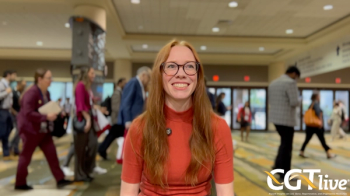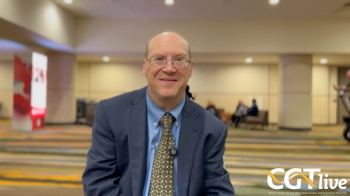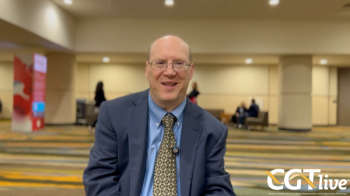
Studies Highlight Rationale for Immunotherapy in Early-Stage and Locally Advanced NSCLC
With durvalumab (Imfinzi) being hailed as a potentially practice changing therapy in locally advanced non–small cell lung cancer, ongoing studies are seeking to determine the efficacy of immunotherapy in earlier stages of disease.
Rathi N. Pillai, MD
With durvalumab (Imfinzi) being hailed as a potentially practice-changing therapy in locally advanced non—small cell lung cancer (NSCLC), ongoing studies are seeking to determine the efficacy of immunotherapy in earlier stages of disease.
"We have a lot of exciting things to look forward to in using immunotherapy in earlier stages of lung cancer," said Rathi N. Pillai, MD, in a presentation during the 5th Annual Miami Lung Cancer Conference. Pillai is an assistant professor in the Department of Hematology and Medical Oncology at Emory University School of Medicine, and a member of the Discovery and Developmental Therapeutics Research Program at Winship Cancer Institute.
A recent immunotherapeutic advance in this space includes the February 2018 FDA approval of durvalumab, a PD-L1 inhibitor, for the treatment of patients with locally advanced, unresectable stage III NSCLC who have not progressed following chemoradiotherapy.1 The approval was based on pivotal data from the phase III PACIFIC trial, in which most enrolled patients were current or former smokers (91%), men (70.1%), and had squamous histology (45.7%).
"It has been thought that perhaps introducing immunotherapy immediately after radiation and chemotherapy would make sense because the immune system would be primed from the release of tumor antigen from their prior therapy," Pillai explained. "The PACIFIC study specifically looked at this question."
In PACIFIC, patients were randomly assigned to durvalumab (n = 443) or placebo (n = 213) following chemoradiation. The objective response rate with durvalumab was significantly higher than that of placebo (28.4% vs 16.0%; P <.001).
The median duration of response was not reached in the durvalumab arm versus 13.8 months in the placebo arm. Of the patients who had a response to durvalumab, 72.8% had an ongoing response at both 12 and 18 months versus 56.1% and 46.8%, respectively, in the placebo arm.
Durvalumab was also associated with a significant improvement in median progression-free survival (PFS) at 16.8 versus 5.6 months for placebo (hazard ratio [HR], 0.52; 95% CI, 0.42-0.65; P <.0001). The 12-month PFS rate was 55.9% versus 35.3%, and the 18-month PFS rate was 44.2% versus 27.0%, with durvalumab and placebo, respectively.
Overall survival (OS) data were not mature. AstraZeneca, the manufacturer of durvalumab, plans to submit an update on the final OS analysis to the FDA as part of its approval.
"Durvalumab had a very impressive statistically significant and, I would say, clinically significant improvement in median PFS in this analysis," said Pillai, adding that the PFS benefit was observed across all patient subgroups and was independent of PD-L1 expression status.
Investigators had initial concerns over using durvalumab in this setting as it could potentially increase the risk of rate of pneumonitis, which is commonly observed following chemoradiation. However, data showed little increase in incidence of grade 3/4 pneumonitis between the two arms at 3.4% (n = 16) and 2.6% (n = 6) with durvalumab and placebo, respectively. Any-grade rates of pneumonitis were 33.9% in the durvalumab arm compared with 24.8% in the placebo arm.
"The use of durvalumab in the consolidation setting after concurrent chemoradiation significantly improves PFS, and in looking at secondary endpoints, durvalumab was also deemed to be favorable," Pillai said. "This regimen appears to be safe with no increased risk of pneumonitis."
Nivolumab (Opdivo) has also demonstrated efficacy as a monotherapy and in combination in patients with earlier stages of NSCLC. In a phase II safety and feasibility trial, 20 patients with newly diagnosed, stage IB to IIIA resectable NSCLC were treated with 2 doses of nivolumab at 3 mg/kg over 4 weeks prior to surgery.2 Eighteen patients were current or former smokers.
Following surgery and standard postoperative treatment, data showed that 43% of patients had a major pathologic response (95% CI, 24%-63%) and at median follow-up of 9 months, 18 patients (86%) remain alive and recurrence free. Per RECIST v1.1 criteria, the partial response rate was 10%, the stable disease rate was 85%, and the progressive disease rate was 5%.
"Nivolumab did not delay or interfere the surgical resection in any way, which was very encouraging, and nivolumab in the neoadjuvant setting was also very safe," Pillai said, noting that observed toxicities were consistent with prior experience in checkpoint inhibitor therapy.
Additionally, there was an influx of PD-L1-positive and CD8-positive T cells via immunohistochemistry following treatment. Overall, the investigators concluded that nivolumab treatment did not delay surgery, and that the major pathologic response rate was encouraging and compares favorably with cisplatin-based neoadjuvant chemotherapy.
Through evaluation of genomic analyses, it is possible, Pillai noted, that higher tumor mutation burden and MANA-specific T-cell receptors in the peripheral blood and tumor, which had increased after nivolumab therapy, could be potential biomarkers for response.
There are other clinical trials exploring immunotherapy agents that have been approved in more advanced stages of lung cancer, Pillai said. The multicenter, open-label, single-arm, phase II LCMC3 trial conducted by the Lung Cancer Mutation Consortium is evaluating the safety and efficacy of neoadjuvant and adjuvant treatment with atezolizumab (Tecentriq) in patients with resectable NSCLC (NCT02927301).
Neoadjuvant therapy will consist of two 21-day cycles of atezolizumab and, following resection, patients who demonstrate clinical benefit with neoadjuvant therapy will undergo adjuvant therapy with atezolizumab for up to 12 months. Major pathologic response is the primary endpoint.
A similarly designed multicenter, phase II trial is being conducted with pembrolizumab (Keytruda). For patients with stage IB to IIIA NSCLC, researchers will explore 2 doses of neoadjuvant pembrolizumab and 4 doses administered as adjuvant therapy.
In the phase III IMpower010 study (NCT02486718), investigators are exploring atezolizumab versus best supportive care following adjuvant cisplatin-based chemotherapy in patients with completely resected stage IB to IIIA NSCLC in a planned cohort of 1127 patients.
After completion of up to 4 cycles of adjuvant cisplatin-based chemotherapy, patients will undergo a 1:1 randomization to receive atezolizumab for 16 cycles or best supportive care. Disease-free survival (DFS) in the intent-to-treat and PD-L1-expressing populations are the co-primary endpoints, with OS, 3-year and 5-year DFS rates, and safety in the ITT group as secondary endpoints.
Additional work in the field regarding immunotherapy includes the phase III ANVIL study (NCT02595944), Pillai said, which is comparing adjuvant treatment with 240 mg of intravenous nivolumab biweekly for up to 1 year with standard observation in EGFR or ALK wild-type patients who were enrolled on the ALCHEMIST screening trial. Long-term follow-up will determine whether adjuvant PD-1 inhibitor therapy improves DFS and OS.
Biomarker development remains an integral question as immunotherapy movies into early-stage NSCLC, Pillai concluded.
References
- Antonia SJ, Villegas A, Daniel D, et al. Durvalumab after chemoradiotherapy in stage III non-small-cell lung cancer. N Engl J Med. 2017;377(20):1919-1929 doi: 10.1056/NEJMoa1709937.
- Chaft JE, Forde PM, Smith KN, Anagnostou V, Cottrell T, Taube JM. Neoadjuvant nivolumab in early-stage, resectable non-small cell lung cancers. J Clin Oncol. 2017;35 (suppl 8508). doi: 10.1200/JCO.2017.35.15_suppl.8508.
Newsletter
Stay at the forefront of cutting-edge science with CGT—your direct line to expert insights, breakthrough data, and real-time coverage of the latest advancements in cell and gene therapy.
















































